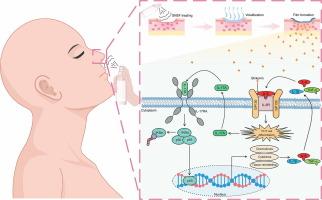紫草素鼻喷膜制备通过与白细胞介素-6的相互作用促进鼻黏膜损伤的修复
IF 13
1区 综合性期刊
Q1 MULTIDISCIPLINARY SCIENCES
引用次数: 0
摘要
鼻喷雾膜是近年来的一种创新配方,由于它结合了喷雾和薄膜配方的优点,易于应用,同时降低了液滴形成和进一步吸入喉咙的风险,因此获得了鼻黏膜损伤患者的显著好评。此外,紫草是一种常用的治疗皮肤损伤的中药,我们的前期工作表明其主要化合物紫草素具有促进鼻黏膜损伤修复的能力。尽管取得了这些令人鼓舞的成果,但对紫草素鼻喷膜制剂的开发及其生物活性机制的研究仍然有限。目的制备SNSF,研究其促进鼻黏膜损伤修复的机制和药动学特性,为其后续临床应用提供参考。方法制备SNSF,通过粒度分析、热重分析、扫描电镜对其结构性能进行表征,并对其材料性能(粘度、成膜时间、吸湿性、保湿性、透气性、透皮渗透性能)进行评价。同时,通过RNA-seq、western blotting、RT-PCR、生物层干涉、超滤亲和和分子模拟等方法探讨SNSF的修复机制。此外,通过HPLC-MS/MS分析了SNSF的药代动力学,进一步证明了其临床应用潜力。结果紫草素在不影响材料性能的情况下,成功吸附在喷雾膜表面,获得了SNSF。同时,SNSF治疗显著减轻了炎症反应,促进了鼻黏膜损伤的修复。这种治疗效果可能归因于其活性化合物紫草素,它与IL-6结合,随后激活IL-17信号通路。此外,SNSF具有吸收快、半衰期短的特点,进一步提高了紫草素的生物利用度。结论snsf是一种治疗鼻黏膜损伤的新型候选药物,具有很大的临床应用潜力。本文章由计算机程序翻译,如有差异,请以英文原文为准。

Shikonin nasal spray film preparation promoted the repair of nasal mucosal injury by the interaction of shikonin with interleukin-6
Introduction
Nasal spray films, an innovative formulation in recent years, have garnered significant acclaim from patients with nasal mucosal injury because it integrate the benefits of spray and film formulation, offering ease of application while reducing the risk of droplet formation and further inhalation into the throat. Furthermore, Lithospermum erythrorhizon is a traditional Chinese medicine frequently employed in the management of dermal injuries, and our previous work suggested its major compound, shikonin, possesses the capacity to promote the repair of nasal mucosal injury. Notwithstanding these encouraging results, research on the development of shikonin nasal spray film preparation (SNSF) and its bioactivity mechanism remains limited.Objectives
This work aimed to formulate SNSF and examine its mechanisms and pharmacokinetic properties in facilitating the repair of nasal mucosal injury, thereby offering insights for its subsequent clinical application.Methods
The SNSF was prepared, and its structural properties were characterized through particle size analysis, thermogravimetric analysis, scanning electron microscopy, and its material properties, including viscosity, film-forming duration, moisture absorption, moisture retention, breathability, and transdermal permeation efficacy, were evaluated. Simultaneously, the repair mechanism of SNSF was explored with RNA-seq, western blotting, RT-PCR, bio-layer interferometry, ultrafiltration affinity, and molecular simulation. Additionally, the pharmacokinetics of SNSF were revealed by HPLC-MS/MS to further demonstrate its clinical application potential.Results
Shikonin successfully adsorbs on the surface of spray film to obtain SNSF without affecting its material properties. Meanwhile, SNSF treatment significantly alleviated the inflammatory response and facilitated the repair of nasal mucosal injury. This therapeutic effect might be attributed to its active compound, shikonin, which binds to IL-6 and subsequently activates the IL-17 signaling pathway. Additionally, SNSF possessed the characteristics of fast absorption, short half-life, and further enhanced bioavailability of shikonin.Conclusion
SNSF is a novel candidate drug with great clinical potential for patients with nasal mucosal injury.求助全文
通过发布文献求助,成功后即可免费获取论文全文。
去求助
来源期刊

Journal of Advanced Research
Multidisciplinary-Multidisciplinary
CiteScore
21.60
自引率
0.90%
发文量
280
审稿时长
12 weeks
期刊介绍:
Journal of Advanced Research (J. Adv. Res.) is an applied/natural sciences, peer-reviewed journal that focuses on interdisciplinary research. The journal aims to contribute to applied research and knowledge worldwide through the publication of original and high-quality research articles in the fields of Medicine, Pharmaceutical Sciences, Dentistry, Physical Therapy, Veterinary Medicine, and Basic and Biological Sciences.
The following abstracting and indexing services cover the Journal of Advanced Research: PubMed/Medline, Essential Science Indicators, Web of Science, Scopus, PubMed Central, PubMed, Science Citation Index Expanded, Directory of Open Access Journals (DOAJ), and INSPEC.
 求助内容:
求助内容: 应助结果提醒方式:
应助结果提醒方式:


